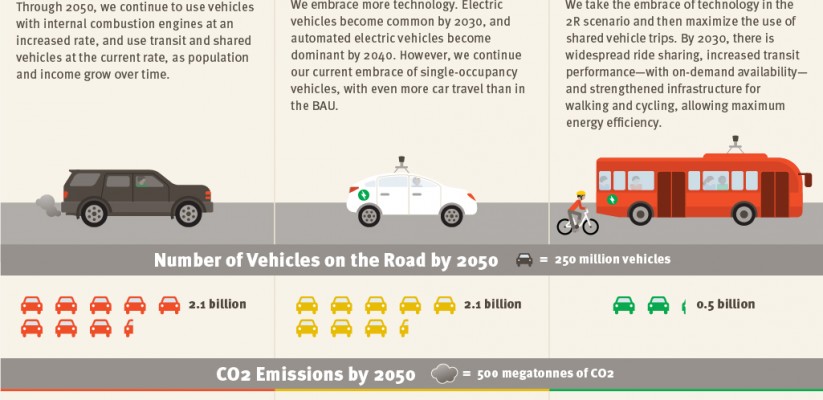Three Revolutions in Urban Transportation / Lew Fulton, Jacob Mason, Dominique Meroux
Three Revolutions in Urban Transportation. How to achieve the full potential of vehicle electrification, automation and shared mobility in urban transportation systems around the world by 2050 / Lew Fulton, Jacob Mason, Dominique Meroux. – UC Davis, ITDP (Institute for Transportation & Development Policy), New York, 2017, 41 p. [formato PDF, 2,4 MB].
Analysis from ITDP and UC Davis shows 3R synergy provides 40% reduction in urban vehicle transportation costs globally by 2050. Ride-sharing and renewable energy sources critical to its success.
As the transportation trends of passenger vehicle automation and electrification continue, new research concludes that adding extensive ride sharing to the mix could reduce CO2 emissions from all transportation sources around the globe by more than 80 percent. The report, “Three Revolutions in Urban Transportation,” examined these three revolutions in urban transportation and found all three together could cut the cost of vehicles, infrastructure and transportation system operation by more than 40 percent.
The new report was produced by the University of California, Davis, and the Institute for Transportation and Development Policy. It compares the environmental and fiscal impacts of three scenarios involving new transportation technology:
- 1 Business-as-usual (BAU) scenario—Through 2050, we continue to use vehicles with internal combustion engines at an increased rate, and use transit and shared vehicles at the current rate, as population and income grow over time.
- 2 Revolutions (2R) scenario—We embrace more technology. Electric vehicles become common by 2030, and automated electric vehicles become dominant by 2040. However, we continue our current embrace of single-occupancy vehicles, with even more car travel than in the BAU.
- 3 Revolutions (3R) scenario—We take the embrace of technology in the 2R scenario and then maximize the use of shared vehicle trips. By 2050, cities have ubiquitous private car sharing, increased transit performance—with on-demand availability—and strengthened infrastructure for walking and cycling, allowing maximum shared trip efficiency.
This report expands upon the scope of the previous studies by considering the role of electrification, automation, and ride sharing (more people per vehicle) in developing future scenarios. The possible types of impacts are well documented, and researchers have begun to estimate how various combinations of impacts – such as people spending more time in their cars, or on-demand mobility trips substituting for public transport – may affect travel and energy use. But most studies have not explicitly projected numeric scenarios into the future or attempted to characterize how various interactions could play out.
Our central finding is that the 3R scenario is the best option for reducing energy use and CO2, and performs significantly better than 2R in these respects as well as on total measured cost. The 3R scenario would also dramatically reduce the number of vehicles on the world’s roads. This finding is true worldwide and for each individual country or region studied.
